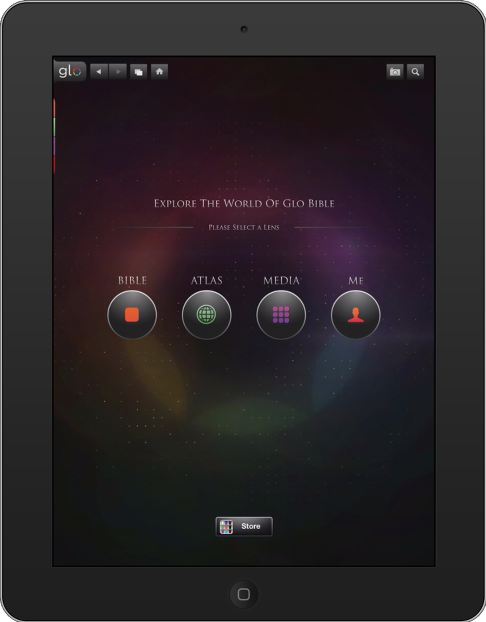

Today I'm reviewing a very interesting next generation religious eBook named Glo. The digital religious and eBook communities don't tend to talk to each other. However, the work happening in these digital religious communities around eBooks is incredibly interesting for several reasons.
First, religious texts are incredibly stable from the perspective that they are generally historical documents. This means that they can affordably support tremendous amounts of metadata and multimedia because they are so stable from a textual standpoint. In fact, one of the earliest forms of hypertext can be considered the addressing mechanism in the Jewish and Christian testaments in terms of naming their books and giving paragraph and word offsets, such as John 3:14.
Second, there are communities that find these books so important that they're willing to invest the tremendous amounts of time and energy needed to create deep levels of paratext and digital enhancements. It's not surprising that literally the first use of the Gutenberg Press was printing versions of the Christian testament.
Finally, there's a built-in audience of people who are willing to spend money on these enhanced eBooks. They find it important enough to not just have a textual version of the Bible, but want a supercharged version enhanced in interesting ways.
Religious texts are stable and long lived, and can therefore support tremendous amounts of metadata and multimedia.
For these reasons I like to keep a close check on what digital religious communities are doing around eBooks, independent of whatever their traditions are such as the Muslim, Buddhist, Jewish, or Christian communities.
Today I want to take you through one of the most interesting digital eBooks from one of these religious communities, named Glo. Glo has versions for many different devices and operating systems. Today I'm going to take you through the iOS version on my iPad.
When you first open Glo you are presented with what it calls different lenses: these provide an independent way to experience the text in different ways:

The first lens is the Bible lens, which allows you to go into the actual text of the bible yourself. The second lens is the Atlas which overlays all of the actual locations of the events of the Bible across a geographic atlas. The final lens is the Media lens that contains external commentary, pictures, videos, and sounds with multimedia enhancements that surround the text and provide alternative entry points.
Let's start with the Bible lens. Clicking on this actually shows a zoomed out image with the Jewish and Christian Testaments. Clicking on any of these actually will zoom you into one of these articles and show you a little bit more information. Finally you can zoom in even more and into the actual text:
Now here's the cool part. Once inside the text, you can click on any paragraph and see a small icon to the side. Clicking on the icon allows the user to pivot along the other lens. For example, clicking on the Media lens would allow you to pivot and see actual pictures of the location being spoken about today. The actual pictures themselves are smart: many of them have their own overlays that point deeper to other pictures, parts of the Atlas, or other articles. It might show you articles providing further commentary or extra supplementary information.
Someone can also pivot the lens based on the Atlas. If we go back to our earlier example and click on Atlas, we are taken to a map showing the region being discussed in the specific text being read. We can zoom into the map using pinch to zoom and actually click on different locations and see other parts of the Bible that refer to this location and then click on those and pivot to them:
Now here's something really interesting. Maps change over time. Countries rise and fall. The Atlas therefore has different versions of the map that change over time so you can understand how these regions evolve through history. In addition, these different maps help provide information on the flow of history as interpreted by the Bible.
What makes this eBook so well done is the fact that the entire text has been deeply interwoven with this metadata and these pivots. It's almost like what academia calls digital humanities but rolled into a consumer book with an interface that is readily accessible.
Two other nice small features that show how well done this next generation eBook is is the fact that in the text you can easily toggle between four different versions of the Bible:
There is also a way to zoom out and see all of the different sections you've visited to quickly jump between areas in order to support nonlinear study:
I would love to see this kind of care and interactivity brought to nonreligious texts, such as Marco Polo's Travelogues or Livy's The Early History of Rome. These are also texts that are stable and can support connecting to metadata to help you understand where they took place geographically in both the ancient and modern worlds or provide supporting articles and media to understand and make these classics richer and more accessible.
If we can successfully lower the effort it takes to create these kind of amazing works, and invent the business models to allow publishers to see a return on making these kinds of investments, empower teams of volunteers to create these kinds of texts, or have academia help provide the paratext scaffolding for these works via their digital humanities initiatives, I think we can transform the art of reading.
Subscribe to my RSS feed and follow me on Twitter to stay up to date on new posts.
Please note that this is my personal blog — the views expressed on these pages are mine alone and not those of my employer.